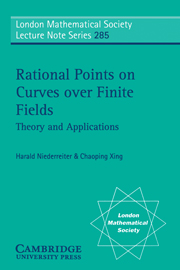Book contents
- Frontmatter
- Contents
- Preface
- 1 Background on Function Fields
- 2 Class Field Theory
- 3 Explicit Function Fields
- 4 Function Fields with Many Rational Places
- 5 Asymptotic Results
- 6 Applications to Algebraic Coding Theory
- 7 Applications to Cryptography
- 8 Applications to Low-Discrepancy Sequences
- A Curves and Their Function Fields
- Bibliography
- Index
7 - Applications to Cryptography
Published online by Cambridge University Press: 05 April 2013
- Frontmatter
- Contents
- Preface
- 1 Background on Function Fields
- 2 Class Field Theory
- 3 Explicit Function Fields
- 4 Function Fields with Many Rational Places
- 5 Asymptotic Results
- 6 Applications to Algebraic Coding Theory
- 7 Applications to Cryptography
- 8 Applications to Low-Discrepancy Sequences
- A Curves and Their Function Fields
- Bibliography
- Index
Summary
It has been known at least since the invention of elliptic-curve cryptosystems in 1985 that algebraic curves over finite fields can be very useful for cryptography. Elliptic-curve cryptosystems have already been treated extensively in several books (see for instance Blake, Seroussi, and Smart [11], Enge [21], Koblitz [59], and Menezes [81]), and so we focus here on other, and more recent, applications of algebraic curves over finite fields to cryptography in which rational points of the curve play a role. Specifically, we discuss applications to stream ciphers, to the construction of hash functions, and to the construction of authentication schemes. As usual in this book, we prefer to use the equivalent language of algebraic function fields rather than the language of algebraic curves.
Background on Stream Ciphers and Linear Complexity
A cryptosystem is a basic tool for data security that transforms data in original form (plaintexts) into protected data in encrypted form (ciphertexts) and, vice versa, recovers plaintexts from ciphertexts by decryption. The encryption and decryption schemes depend on the choice of parameters (keys) from an extremely large set of possibilities. A fundamental distinction is made between public-key cryptosystems (such as the elliptic-curve cryptosystem) and symmetric cryptosystems. In a public-key cryptosystem, the encryption key K is public knowledge and only the decryption key K1 is kept secret from unauthorized users.
- Type
- Chapter
- Information
- Rational Points on Curves over Finite FieldsTheory and Applications, pp. 170 - 190Publisher: Cambridge University PressPrint publication year: 2001

